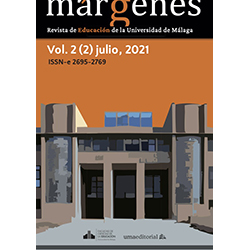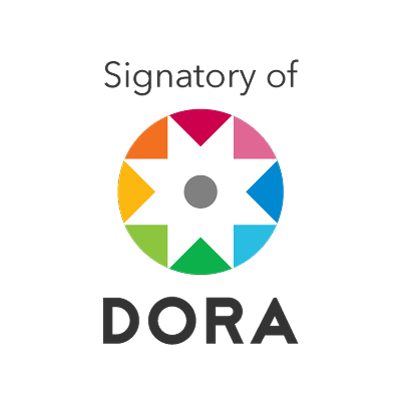A community look at the school: the diagnosis of the neighbourhood as a starter for Service-Learning projects
DOI:
https://doi.org/10.24310/mgnmar.v2i2.10574Keywords:
diagnosis, service-learning, pedagogical method, community education, context analysisAbstract
Service-Learning (SL) is an appropriate experience to consolidate a socio-community view of education, since it encourages the active, reflective and critical participation of all those agents involved. This article shows the diagnostic phase of a neighbourhood where a SL program is applied. At the methodological level, the need to establish a diagnosis of the context where the intervention takes place is theoretically justified and argued, describing the approach, process and criteria used for the selection of the instruments. As a result, a series of instruments are described that facilitate the collection of information from the different groups. In conclusion, the article evidences the need to implement, whenever aspiring to apply quality SL projects, a well-designed diagnostic phase adjusted to the circumstances of each context. It is clear that a transforming proposal that involves the actions of families and the community, must be preceded by a diagnosis of the context in which it takes place, it is to say, an analysis that makes it possible to energize this joint work. Therefore, it will be necessary to design instruments that facilitate the collection of information from the different groups, to identify the strengths and weaknesses, in order to implement quality projects, appropriate to the circumstances of the context. This is the main objective of this work, to provide the instruments that facilitate a diagnosis of the neighbourhood where a Service-Learning program is applied and the contributions that they imply in a specific program.
Downloads
Metrics
Publication Facts
Reviewer profiles N/A
Author statements
Indexed in
-
—
- Academic society
- N/A
- Publisher
- Universidad de Málaga
References
Albarrán Torres, F., et al. (2018). Maquetas como estrategia didáctica en estudiantes de la salud. Educación Médica. 2018. DOI: http://dx.doi.org/10.1016/j.edumed.2018.08.003.
Billig, Shelley H. (2002). Support for K–12 service learning practice: A brief review of the research. Educational Horizons. 80,184–189. https://bit.ly/2Kk5R4v
Bringle, R., y Hatcher, J. (1995). A service-learning curriculum for faculty. The Michigan Journal of Community Service-Learning. 2, 112-122. https://bit.ly/2WrNpJz
Caballo, B. & Gradaílle, R. (2008). La educación social como práctica mediadora en las relaciones escuela-comunidad local. Pedagogía Social. Revista Interuniversitaria. (15), 45-55. DOI: https://doi.org/10.7179/PSRI_2008.15.04
Cabedo, A. (2014a). La música como proyecto socioeducativo. In A. Giráldez, Didáctica de la música en primaria (pp. 101-122). Madrid: Síntesis.
Cabedo, A. (2014b). La música comunitaria como modelo de educación, participación e integración social. Eufonía: didáctica de la música. 60, 15-23.
Cámara, Á., Díaz, E. y Ortega, J. (2017). Aprendizaje servicio en la universidad: ayudando a la escuela a atender la diversidad a través de las TIC. Bordón. Revista de Pedagogía. 69(3), 73-87. DOI: http://dx.doi.org/10.13042/Bordon.2017.51320.
Carrington, S. y Saggers, B. (2008). Service-learning informing the development of an inclusive ethical framework for beginning teachers. Teaching and Teacher Education. 24(3), 795-806. DOI: http://dx.doi.org/10.1016/j.tate.2007.09.006.
Carrington, S., Mercer, K. L., Iyer, R. y Selva, G. (2015). The impact of transformative learning in a critical service-learning program on teacher development. Reflective Practice. 16(1), 61-72. DOI: http://dx.doi.org/10.1080/14623943.2014.969696.
Carter, G. R. (1997). Service-learning in curriculum reform. In Schine, J. (Ed.), Service learning: Ninety-sixth year book of the National Society for the Study of Education, Part I (pp. 69-78). Chicago: University of Chicago Press.
Ceballos, E. (2006). Dimesiones de análisis del diagnóstico en educación: El diagnóstico del contexto familiar. RELIEVE. 12 (1), 33-47. (Recuperado de https://bit.ly/2HHSpWi).
Chang, S., Anagnostopoulos, D. y Omae, H. (2011). The multidimensionality of multicultural service learning. Teaching and Teacher Education. 27(7), 1078-1089. DOI: http://dx.doi.org/10.1016/j.tate.2011.05.004.
Chiva-Bartoll, Ó., Peris, C. C., & Piquer, M. P. (2018). Investigación-acción sobre un programa de aprendizaje-servicio en la didáctica de la educación física. Revista de investigación educativa, 36(1), 277-293.
Chiva-Bartoll, O., Santos-Pastor, M. L., Martínez-Muñoz, F. & Salvador-García, C. (2019). Valoración del impacto del aprendizaje- servicio universitario en el ámbito de la actividad física y el deporte: una propuesta desde la teoría de stakeholders. Publicaciones, 49(4), 27-46
Chiva-Bartoll, O., Salvador-García, C., Ferrando-Félix, S., & Cabedo-Mas, A. (2019). Aprendizaje-servicio en educación musical: revisión de la literatura y recomendaciones para la práctica. Revista Electrónica Complutense de Investigación en Educación Musical.16, 57-74.
Cieza-García, J. A. (2006). Educación comunitaria. Revista de educación. 339, 765-799.
Deeley, S. (2016). El Aprendizaje Servicio en educación superior. Teoría, práctica y perspectiva crítica. Madrid: Narcea. https://bit.ly/3p6Za4G
Fair, Cintya. D., & Delaplane, E. (2015). It is good to spend time with older adults. You can teach them, they can teach you: Second grade students reflect on intergenerational service learning. Early Childhood Education Journal. 43(1), 19-26. DOI: http://dx.doi.org/10.1007/s10643-014-0634-9.
Fernández, E. (2016). Habitar las ciudades a través de metodologías participativas y procesos de transformación social: pedagogías de la democracia ausente y recuperación del espacio público. En Villena J.L. & Molina E. (2016). Ciudades con vida: Infancia, participación y movilidad (pp. 69-102). Barcelona: Grao.
Flyvbjerg, B. (2006). Five misunderstandings about case-study research. Qualitative Inquiry. 12, 219-245. DOI: https://doi.org/10.1177/1077800405284363
Hodge, K., and Sharp, L. A. (2016). Case studies. En Smith, B. & Sparkes A. (Eds.). Routledge handbook of qualitative research in sport and exercise (pp. 62-75). New York: Routledge. https://bit.ly/3akGc6p
Kielsmeier, J. (2003). A time to serve, a time to learn: New roles for youth. Generator. 21(3), 5-14.
Lleixà, T. y Nieva, C. (2018). The social inclusion of immigrant girls in and through physical education. Perceptions and decisions of physical education teachers, Sport, Education and Society. DOI:10.1080/13573322.2018.1563882.
Longás, J., Civís, M., Riera, J., Fontanet, A., Longás, E., & Andrés, T. (2008). Escuela, educación y territorio. La organización en red local como estructura innovadora de atención a las necesidades socioeducativas de una comunidad. Pedagogía Social. Revista Interuniversitaria. (15), 137-151. DOI: https://doi.org/10.7179/PSRI_2008.15.11
Mergler, A., Carrington, S., Kimber, M., Bland, D. y Boman, P. (2017). Exploring the Value of Service-Learning on Preservice Teachers. Australian Journal of Teacher Education. 42(6), 69-80. DOI: http://dx.doi.org/10.14221/ajte.2017v42n6.5.
O’Meara, J., Huber, T. y Sanmiguel, E. (2018). The role of teacher educators in developing and disseminating global citizenship education strategies in and beyond US learning environments. Journal of Education for Teaching. Epub. DOI:10.1080/02607476.2018.1516347
Opazo, H. y Aramburuzabala, P. (2019). Service Learning in Teacher Training – A Case Study of the Autonomous University of Madrid. En P. Aramburuzabala, L. McIlrath y H. Opazo (eds.), Embedding Service-Learning in European Higher Education (pp. 154-165). Londres: Routledge. DOI: https://doi.org/10.4324/9781315109053
Ortiz de Zárate Arriola, E. (2014). La maqueta como un recurso educativo para una didáctica del entorno urbano en la educación secundaria obligatoria. (Tesis Fin de Máster). Universidad Internacional de la Rioja, La Rioja. (Recuperado de https://bit.ly/30sFHkT).
Palpacuer-Lee, C. y Curtis, J. H. (2017). Into the Realm of the Politically Incorrect: Intercultural Encounters in a Service-Learning Program. International Journal of Multicultural Education. 19(2), 163-181. DOI: http://dx.doi.org/10.18251/ijme.v19i2.1239.
Parrilla Latas, Á., Muñoz-Cadavid, M. A., & Sierra Martínez, S. (2014). Proyectos educativos con vocación comunitaria. Revista de Investigación en Educación, 11(3) pp. 15-31
Peralta, L., O’Connor, D., Cotton, W. y Bennie, A. (2016). Pre-service physical education teachers’ indigenous knowledge, cultural competency and pedagogy. Teaching Education. 27(3), 248-266. DOI: http://dx.doi.org/10.1080/10476210.2015.1113248.
Rodríguez, A., & Cabedo, A. (2017). Espacios musicales colectivos durante y después del conflicto armado como lugares de preservación del tejido social. Revista Co—herencia Universidad EAFIT—Departamento de Humanidades, 14(26).
Sales Ciges, A. y Garcia López, R. (1997). Programas de Educación Intercultural. Bilbao: Desclée De Brouwer.
Scales, Peter. C., Blyth, Dale. A., Berkas, Thomas. H., & Kielsmeier, James. C. (2000). The effects of service-learning on middle school students’ social responsibility and academic success. The Journal of Early Adolescence. 20(3), 332-358. DOI: https://doi.org/10.1177/0272431600020003004
Tracy, S. J. (2010). Qualitative quality: Eight ‘big tent’ criteria for excellent qualitative research. Qualitative Inquiry. 16, 837-851. DOI: https://doi.org/10.1177/1077800410383121
Villena, J. L. (2015). Reivindicando el presente desde la infancia. En Villena, J.L. & Molina, E. (2015). Ciudades con vida: Infancia, participación y movilidad (pp. 9-11). Barcelona: Graó. https://bit.ly/38kVvJL
Williams, D. R. (2016). Service-learning and the hungry and homeless: Tangible sensibilities of care among young urban adolescents. Children, Youth and Environments. 26(1), 164-178. DOI: http://dx.doi.org/10.7721/chilyoutenvi.26.1.0164.
Downloads
Published
How to Cite
Issue
Section
License
The editorial team of Márgenes supports an open Access policy of scientific knowledge. apostamos claramente por una política de acceso abierto del conocimiento científico (see Berlin Declaration).
Authors with work published in this journal accept the following conditions:
- This journal provides immediate free access to its content under the principle of making research freely available to the public. All contents published in Márgenes are subject to the Creative Commons Reconocimiento-SinObraDerivada 4.0 Internacional
It is the responsibility of the authors to obtain the necessary permissions of the images that are subject to copyright.
Authors whose contributions are accepted for publication in this journal will retain the non-exclusive right to use their contributions for academic, research and educational purposes, including self-archiving or deposit in open-access repositories of any kind.
The electronic edition of this magazine is edited by the Editorial of the University of Malaga (UmaEditorial), being necessary to cite the origin in any partial or total reproduction.
- Authors can enter into other additional independent contractual agreements for the non-exclusive distribution of the version of the article published in this journal (e.g. including it in an institutional repository or publishing it in a book) on the condition that they clearly indicate that the work was originally published in this journal.
- Authors are allowed and recommended to publish their work on the Internet (for example on institutional and personal websites), before and after the publication, as this could lead to constructive exchanges and a more extensive and quick circulation of published works (see The Effect of Open Access).















